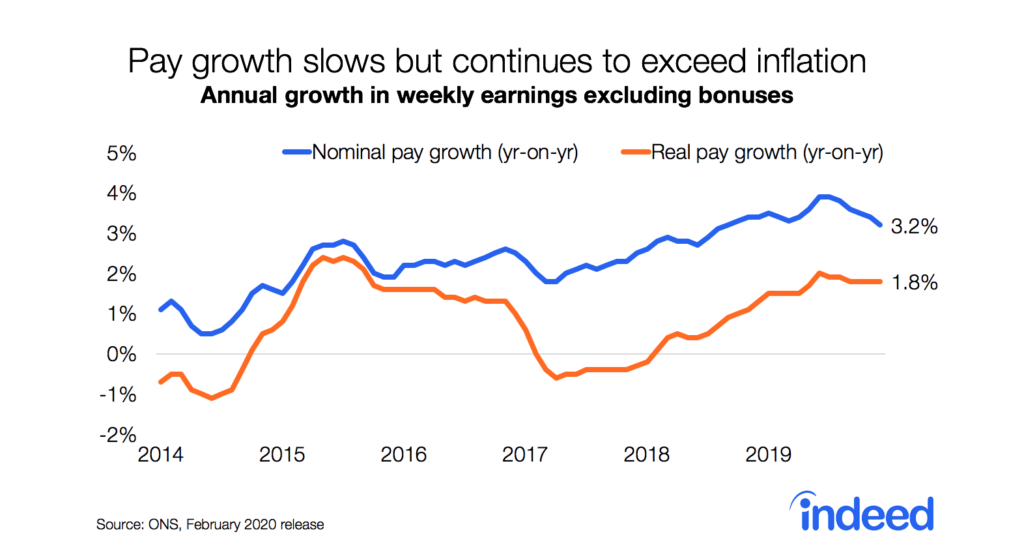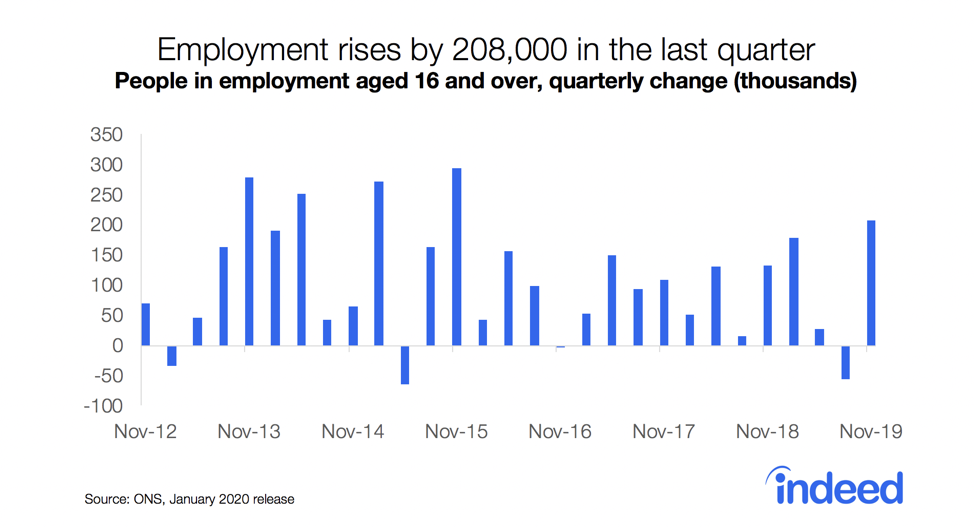Key points:
- Britain has become less popular with EU jobseekers since post-Brexit immigration rules were put in place in January 2021, with overall searches down 36% and clicks on lower-paid jobs off 41% since 2019.
- Searches from elsewhere in the world have been remarkably stable — and have even risen significantly for higher-paid jobs — driven by jobseekers from current and former Commonwealth countries and Hong Kong.
- Employers who want to hire foreign workers for lower-paying jobs face substantial obstacles.
Five years from the June 2016 Brexit referendum, the UK labour market is feeling its consequences. New immigration rules have altered jobseeker search patterns on Indeed UK. EU jobseekers are less inclined to search for UK jobs, with lower-paid positions seeing the greatest fall-off in clicks. At the same time, interest from jobseekers outside the EU has been stable and higher-paid jobs have actually registered a substantial increase.
Freedom of movement from the EU ended at the turn of the year, putting EU jobseekers on an equal footing with their counterparts from the rest of the world. The UK government’s new immigration regime aims to prioritise ‘those with the highest skills’, while making it harder to recruit from abroad for most lower-paid jobs. At the same time, COVID-19 has prompted restrictions on movement across borders, making it more difficult for people to take jobs abroad.
This means that, as the UK economy reopens and job postings grow, employers hiring for higher-paid jobs may be able to replace EU candidates with applicants from the rest of the world. But those hoping to recruit from overseas for lower-paid jobs, including childcare, hospitality and leisure, may face challenges.
EU jobseekers are searching less in the UK
The pandemic and its chilling effect on international mobility do not appear to be the only reason EU jobseeker interest in UK jobs has fallen. COVID-19 certainly played a role in 2020, when EU and non-EU search shares fell 14% and 7% respectively, probably due to coronavirus risk and travel restrictions. However, by May 2021, searches from outside the EU had almost returned to 2019 levels, while searches from within the EU had continued to fall. Searches from EU-based jobseekers had fallen 36% since 2019 as a share of all job searches, while searches from international jobseekers based outside the EU were down just 1%.
The stable trend in jobseeker interest from Ireland is also instructive. While Ireland is part of the EU, Irish citizens retain the right to freely live and work in the UK, even after Brexit, as part of the Common Travel Area arrangements between the two countries.
These trends are consistent with the idea that ending freedom of movement for EU citizens on 1 January 2021 made the UK a less feasible destination for jobseekers based in the EU, many of whom do not qualify for a working visa. The upshot is that UK employers need to rely more on domestic and non-EU candidates now than before Brexit.
Table titled “Share of searches on Indeed UK.” Indeed listed the share of searches on Indeed UK between 2019, 2020, and May 2021 between EU search share and non-EU search share. Searches from EU-based jobseekers had fallen 36% since 2019, while searches from international jobseekers based outside the EU were down 1%.
Falling interest from EU jobseekers affects lower-paid jobs most
Trends in clicks on postings for low-paid jobs also suggest a link between post-Brexit immigration policy and lower interest from EU-based jobseekers. To understand whether shifts in interest from foreign jobseekers are concentrated in specific types of jobs, we grouped occupations into high-, middle- and low-paid tiers based on median posted salaries. We then looked at EU and non-EU jobseeker shares of clicks on postings in each tier.
The low-paid tier includes sectors like cleaning, social care, loading & stocking, childcare, food and hospitality. The middle-paid tier includes such sectors as construction, nursing and real estate. The high-paid tier takes in sectors like finance, tech, medicine and engineering.
Postings in low, middle and high-paying occupations all registered declines in clicks by EU jobseekers but the drop was most pronounced among the lowest-paying jobs — the ones most affected by post-Brexit immigration rules. The share of clicks by EU jobseekers on postings in lower-paying occupations fell from 1.2% in 2019 to 0.7% in May 2021 — a 41% drop in the EU contribution to candidate supply. The shares of clicks in high- and middle-paying occupations fell less — 17% and 22% respectively.
The share of clicks from non-EU jobseekers on postings in low-paid occupations increased only slightly from 0.9% to 1.0% — a 12% rise. Thus, falling EU interest at the lower-paid end of the labour market has not been offset by rising non-EU interest. That reinforces concerns over the difficulty of recruiting candidates for lower-paid occupations, a problem that has been exacerbated by an exodus of foreign workers since the start of the pandemic.
Trends for employers in higher-paying occupations are more encouraging in that the non-EU share of clicks has risen. In May 2021, 5.2% of clicks on postings in the high-paid tier were from non-EU foreign jobseekers, an increase of 39% since 2019. Just 2.4% of clicks in this tier came from EU jobseekers.
Occupations with the biggest falls in EU jobseeker clicks included engineering, childcare, scientific research & development, food preparation & service and sports.
Categories that attracted the highest shares of clicks from outside the UK were largely high-paid jobs that require advanced qualifications. In software development, 18.7% of clicks were from foreign jobseekers, the highest share of any occupation. This represents a substantial increase since 2019, entirely driven by rising non-EU clicks. Mathematics, a category that includes analyst and data scientist jobs, was in second place. Engineering, architecture, scientific research, banking & finance and media & communications roles also attracted high foreign interest. All these categories have seen gains in non-EU click shares since 2019 as EU interest has decreased.
Jobseeker interest from current and former Commonwealth countries is rising
Several current and former Commonwealth countries have notched some of the biggest jumps in click share since 2019, led by India and the former British territory of Hong Kong. Ireland has seen the fifth-biggest increase in click share.
Jobseeker interest in occupations varies considerably by geography. People from India and Pakistan click most on software development jobs. Jobseekers from Nigeria look most at nursing roles. Administrative assistance (administrative and secretarial roles) is the most popular category among workers from Hong Kong and Ireland.
Job searches from Hong Kong spiked after the UK government offered citizenship to around 3 million residents of the special administrative region in July 2020 and have stayed high since.
Meanwhile, several EU countries have posted some of the largest declines in jobseeker interest, including Spain, France and Italy. But it was a non-EU country, the US, that had the biggest drop in click share, likely reflecting the current travel ban.
Conclusion: Job search trends reflect immigration policy changes
The changes in international jobseeker interest in UK positions suggest that the shift in the UK’s immigration regime is working the way the government intends — to “reduce overall levels of migration and give top priority to those with the highest skills”.
That creates difficulties for certain sectors, particularly lower-paid ones, that previously relied on EU workers. This is fuelling concerns about labour shortages. The government has been reluctant to grant extra flexibility in the rules. Instead, it has reiterated its stance that employers should “focus on investing in our domestic workforce, especially those needing to find new employment, rather than relying on labour from abroad.”
At the same time, the government’s prioritisation of high-skilled immigration is reflected in jobseeker interest. Employers looking to hire at the higher-paid end of the labour market are well-placed to tap into new talent pools around the world.
Methodology
We calculated the shares of all searches and clicks on job postings from the UK, EU and countries outside the EU, based on the IP location of the jobseeker.
Salary tier data are based on groupings of occupations into high-, middle- and low-paid tiers, based on median advertised annual salaries and hourly wages in job postings.






